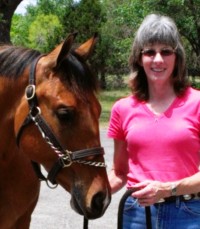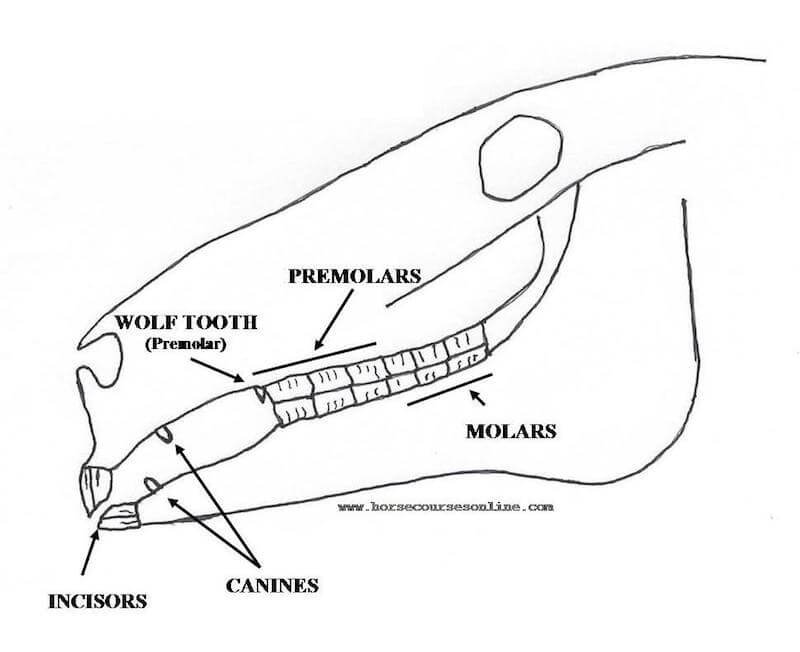Removal of Wolf Teeth Necessary Before Training Begins
By Eleanor Blazer
During a conversation with a new horse owner she mentioned that her trainer had recommended she have the canine teeth removed from her mare. After asking a few questions, I figured out either the horse’s trainer or owner had the canine teeth confused with wolf teeth. This is a common mix-up.
Horses basically have two types of teeth – incisors and molars.
The incisors are across the front. Mature horses will have six on the bottom and six on the top, for a total of 12. The incisors are used for nipping off blades of grass during grazing.
Molars are located behind the interdental space (bars). Adult horses have four premolars and three molars – top and bottom, on each side, for a total of 28. Molars are used for chewing and grinding the feed.

Wolf teeth are premolars with short roots. They are the first set of teeth just past the interdental space. Wolf teeth are present in both males and females, and generally develop during the first six to 12 months of age.
All four wolf teeth may erupt, only one, several, or none at all. The teeth that do not break above the gum line are called “blind”. Wolf teeth do not continue to erupt throughout the horse’s lifetime like the other molars.
Wolf teeth have nerves and a sensitive periodontal ligament that helps hold them in place, and they can cause problems. During training the bit may come in contact with the sensitive tooth resulting in an undesirable reaction – a head toss, which causes another clang against the wolf tooth, resulting in yet another head toss. Even the blind wolf tooth can be sensitive causing the horse to react when the bit makes contact with the area.
Wolf teeth can also erupt in different locations. Instead of being right next to the adjacent premolar the wolf tooth may be closer to the interdental space where the bit will be placed. Frequently this misplaced wolf tooth is blind and hard to detect, but very sensitive.
Wolf teeth should be removed as early as possible, generally when the horse is a yearling and before starting training. At this time the tooth has not matured and fused to the surrounding bone. Consult a qualified equine dentist or veterinarian as wolf teeth contain nerves, blood vessels and the strong ligament which will need to be detached. The horse will require mild sedation.
Do not allow anyone to use a hammer and chisel to knock the wolf tooth out. This is very painful to the horse. Part of the root may be left behind, and nerves exposed, leading to more problems.
Between the age of four and six years another set of teeth will appear in male horses. This set is neither incisors nor molars but are canine teeth or “tushes”. Canine teeth will be located behind the third incisors, in front of the interdental space. A gap will separate the third incisor from the canine tooth. Some mares may develop canines, though generally they will be small buds. Canine teeth do not serve a chewing purpose but can be used for fighting.
The removal of canine teeth is not recommended. The roots are very deep, and removal would be considered major surgery. If the horse is using the canine teeth for aggression veterinarians recommend the teeth be trimmed and buffed. Care must be taken that not too much is trimmed as the pulp can be exposed. This also leaves the teeth viable in case they need to be used as an anchor during a jaw fracture repair.
Canine teeth should not interfere with the bit. If the bit is hanging low enough to clang against the canine teeth the bridle is not adjusted correctly. Handlers must pay attention when removing the bridle – slowly lower the headstall, allowing the horse to work the bit over the canines, so the bit drops gently out of the mouth.
Canine teeth can be very painful when they are erupting or coming in. Trainers and riders of young horses should be aware of the changes going on within the mouth during this time. Just be patient while the canine teeth are erupting, once they are in the sensitivity will diminish.
A tip on how to remember the difference between a canine and wolf tooth: “canine” starts with a “C” as does “colt” and “corner”. The canine tooth is primarily found in male horses and located in the corners of the mouth; wolf teeth can be found in both sexes and are farther back.
* Earn a Bachelor of Science Degree in Equine Studies or certification as a Professional Horse Trainer or Riding Instructor. Start your new career as a riding instructor, horse trainer, or stable manager. All courses are online. Visit www.horsecoursesonline.com for information.
Copyright 2018

Eleanor Blazer was raised training and caring for horses. She learned to ride and care for the horses her family bought and sold. Many of these horses required improved nutrition when they arrived for training. Eleanor’s experience and research has benefited both horses and horse lovers in the field of equine nutrition. An equine nutrition consultant, based in Bulverde, Texas, she keeps busy doing equine nutrition consultations, conducting seminars, and speaking to youth groups about horse care and nutrition. Eleanor is the author of the syndicated column The Way of Horses. She has more than 20 years experience helping and being a mentor to those wanting to know how to provide the very best care and nutrition for our special friend – the horse.






